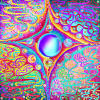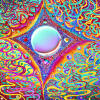
Colony Earth - Part IX: The Buddha & Sufism
Although Gautama Buddha [550-483 BC] was born in a royal Hindu family, he
rejected Hinduism as it was practiced in his lifetime. In ‘The Nighantu and The
Nirukta of Sri Yaskacarya’ which is the oldest Indian treatise on Sanskrit
etymology, the 1920s translator Lakshman Sarup says that there was indeed “early
anti-Vedic scepticism” which possibly influenced the Buddha and “may be
responsible for his vehement denunciation not only of Vedic rites and practices,
injunctions, and invocations, etc., but of Vedic lore.”
Lakshman Sarup quotes from a dialogue found in the
TEVIJJA Sutta in the Digha Nikaya,
which tells of two Brahmanas who are arguing and go to Gautama Buddha to settle
their dispute concerning the true path. The Buddha compares the Vedic Rishis
[the Brahmanas] to “a string of blind men” clinging to each other. “…the talk of
the of the Brahmanas [Rishis] versed in the three Vedas [is] but blind talk…the
three Vedas turn out to be ridiculous, mere words, a vain and empty thing.”
The Buddha declares that reciting Vedic invocations is as useful as asking the
riverbank to move closer, so one may cross the waters. “…the Brahmanas…say thus:
Indra we call upon, Soma we call upon, [etc]…that they, by reason of their
invoking and praying and hoping and praising, should after death …become united
with Brahma [the Oneness] — verily such a condition of things can in no wise
be.”
Gautama Buddha held Vedic rituals up to ridicule and discarded them as an
obstacle to final emancipation. “…Therefore is it that the threefold wisdom of
the Brahmanas, wise in their three Vedas, is called a waterless desert, their
threefold wisdom is called a pathless jungle, their threefold wisdom is called
perdition.” As a scholar of Hinduism, the translator Lakshman Sarup naturally
argues against the Buddha’s vehement assessment of the Vedas, “Nevertheless the
Buddha’s denunciation of the Vedas developed a strong contempt for them in his
followers” and probably “inspired other non-Vedic schools as well.”
I am quoting these words of the Buddha not to diminish the value of the Rig
Veda, but to demonstrate that by Buddha’s time the real meaning of the verses
was already lost — and lost to rites and rituals, which perhaps served the
priests more than the faithful. Krishna says something very similar in the
Bhagavad Gita, Chapter II.46:
“Of no more use than a pool when the entire land is flooded are the Vedas to the
self-realized person.” [Translation by KK
Nair/Krishna Chaitanya]
In II.45, Krishna states that the Vedic rites are useful only in the domain of
the three gunas and urges Arjuna to liberate himself from the confinement of the
plane of the GUNAS, the three modalities of Nature, meaning Prakriti and her
Matrix that manifests the temporal illusory holographic universe. In fact I
often feel that Krishna is also railing against the Brahman priests in the
Bhagavad Gita, just as the Buddha did many centuries later.
In The Bhagavad Gita Chapter II.52, Krishna tells Arjuna that he will become
'disgusted' [nirvedam] with the Vedas once his intelligence [buddhis] has
crossed over delusion, which is described as a thicket of confusion. J.A.B. van
Buitenen translates the verse: “Then you will become disenchanted with what is
supposed to be revealed – and the revealed itself.” In other words, you will not
need or want to continue to read what others have written in books, because the
God-within you will emerge as an ever-expanding fountain of wisdom-knowledge and
reveal everything to you.
Swami Krishnananda says that at some point more reading and more books will only
get in the way. Swami Lakshmanjoo rather humorously said to his disciples in
Kashmir that when they really understood what he was saying, they would not want
to listen to him anymore!

As I have previously stated, it is my conclusion that radiation was dispersed
over planet Earth by the war that brought on the Kali Yuga. This radiation event
altered human DNA and reduced our consciousness, intelligence and perception
down to such a level that we could no longer comprehend the encoded meanings in
the Sanskrit words of the Rig Veda, words that I perceive as being ‘spherical’
layers containing multi-levels of meaning. We just could not ‘grok’ and embrace
non-linear thinking — and thus we fell deeper and deeper into material density,
confusion and delusion.
No wonder the Buddha “ridiculed and discarded” Vedic rituals. Perhaps even the
teachings of Gautama Buddha have been subject to confusion as our descent
through the Kali Yuga progressed. It is my understanding that nothing the Buddha
said was written down until several hundred years after his death. The
possibility for some misinterpretation on the part of well-meaning and devoted
disciples is valid. We all have our own filters.
Krishna understood that each of us comes to God in our own way. In the Bhagavad
Gita Chapter VII.21, he says that no matter in whatever form the Oneness is
approached, revered and worshipped — if that form is the expression of sincere
belief, then we will receive immovable faith [shraddha]. And it is this
adamantine faith that carries us Home, over the delusion thicket and beyond
linear reason.
Bhagavad Gita XVII.3:
"Faith is in accordance with the Truth, [sattva] the essential nature, of each,
Arjuna. Man is made of faith. Whatever faith he has, this he is."
[Translation by Winthrop Sargeant.]

Cooked by Time!
As we humans continued to descend into this Cycle of Time, the Kali Yuga, our
understanding of the Oneness and our ways of worshipping our own God-within went
– as the old saying goes – six-ways from Sunday! Our consciousness became
'cooked' by Time.
The bold and controversial scholar, Malati J. Shendge has described
intelligently and accurately the birth of any ritual, yours and mine: “When the
events became symbolic and were ascribed magical powers to attain certain aims,
the process of mythopoeisation was complete. History was forgotten and dead
ritual became the end in itself.”
For the duration of this Kali Yuga, since 3102 BCE, and very probably throughout
the previous cycle of time, The Dvapara Yuga, there has been no awareness that
there are over 300+ billion galaxies in this universe. With the exception of
gifted Seers who 'saw' in visions a myriad of other worlds and described them as
hierarchies in primordial metaphysics, we simply were not aware of the
possibility of such an immense expanse of Life. Millions of other galaxies could
not have been included in our sciences and religions, even as theories, when we
had no idea that the universe is so vast, larger than any of us had previously
thought or ever conceived of in written history.
Isn't it time to expand our vision of God's creation?
Stuck in 21st century Kali Yuga density, most of us have simply forgotten that
we volunteered. We came to Earth freely to express our God nature in Time and
Space with the ideal of creating amazing gems of data-collecting vehicles,
a.k.a. the DNA of human bodies that may find its way into other galactic realms.
Somewhat bizarrely we are glued to the tube, indulging in compulsive consumption
that never fulfils, and vampirized by demonic frequencies we ourselves created.
In a miasma of amnesia our consciousness is tossed from one useless amusement to
another. Even the air we breathe and the food we eat further diminishes and
degrades our intelligence.
Like the spider who spins its own web, we live in a sort of self-created
gauntlet. However this crazed, boring, and increasingly limited entrapment of
ours is not a punishment, but rather a test of our strength and resilience. A
better comparison is the legendary Labyrinth. We are amazing supercomputers who
have intentionally lost the user’s manual!

Sufism
The Sufi Hazrat Inayat Khan [1882-1927] has much to teach us. Remember that
Doris Lessing became a Sufi before she wrote the very interesting
Canopus in Argos series I wrote
about at length in previous sections. In his book ‘The Heart of Sufism,
Essential Writings of Hazrat Inayat Khan,’ the chapter on Sufi Metaphysics is
highly illuminating. The question is posed: What is the nature of this
manifestation? And his answer is, “It is an interesting dream.”
Hazrat Inayat Khan teaches us that our human bodies are indeed very remarkable.
He says that our body is “an offering from the whole universe.” Our body is an
offering to the soul not only by our parents, but also by the ancestors, the
nation and race and is "the outcome of something that the whole world has
produced for ages: a clay that has been kneaded” over and over by Time.
Hazrat Inayat Khan answers the question, “Why do souls come on earth” with one
word
satisfaction,
for the satisfaction of God. “Because God is the Only Being, and the nature of
being is to become conscious of being...in man this consciousness of being
reaches its culmination. …through man God experiences life at its highest
perfection.” Everything we do or have ever done, we do for God because that
Oneness is who we are and have always been. There is no other!
In Sanskrit this is called the Divine Lila, or God’s Play. I often think that it
is more like a ‘play’ in the sense of a scripted drama — however no one can deny
God’s playfulness. There is evidence everywhere of a childlike love of endless
play, along with an intoxicating and often bewildering sense of humour that
confronts us when we occasionally get wise. The Sanskrit texts say that a human
body is very difficult to get and the opportunity to reunite our consciousness
with the Oneness should be cherished and carefully nurtured. This re-Union is
the reason we came here. The wonderful Kashmir saint and sage, Swami Lakshmanjoo
says, "This whole universe has come into existence just to carry you to God
consciousness!”
In the late 1990s I briefly sat in on a lecture by a famous 'channel' author. I
sat in the back row because I knew I wouldn't be staying long. The lady began
her talk with, "I always knew I was special!" I suppressed a smile - and said to
myself, "Oh yes, lady, you and seven billion others here on planet earth are
indeed very special."
There is only the One, one soul. Here we all are in this temporal illusory
holographic universe, all perceiving ourselves isolated, situated within
different locations moving forward, moving back — always, the Oneness playing.
Remember?

"You are loved and cherished. You have nothing to fear. There is nothing you can
do wrong."
- quoted from 'Proof of Heaven, A Neurosurgeon's Journey into the Afterlife,' by
Eben Alexander, MD; Simon & Schuster, NYC, 2012.
The Nighantu and The Nirukta of Sri Yaskcarya, The Oldest Indian Treatise on
Etymology, Philology and Semantics, Lakshman Sarup; published by Motilal
Banarsidass, Delhi, 1920, 2009.
The Heart of Sufism, Essential Writings of Hazrat Inayat Khan; Shambala
Publications, Inc. Boston, Mass, 1999.
The Civilized Demons: The Harappans in Rig Veda, Malati J. Shendge; Abhinav
Publications, New Delhi, 1977.
The Bhagavadgita in the Mahabharata,
A Bilingual Edition,
Translated & Edited by J.A.B. van Buitenen;
The University of Chicago Press, 1981.
The Bhagavad Gita,
Translated by Winthrop Sargeant;
State University of New York Press, 1994.
The Gita for the Modern Man,
Krishna Chaitanya/KK Nair,
Clarion Books, Delhi.
Out-of -print, ISBN 8185120277
| Questions
or comments about articles on this site: Email V. Susan Ferguson: Click Here |
Copyright© V. Susan Ferguson All rights reserved. |
Technical questions or
comments about the site: Email the Webmaster: Click Here |